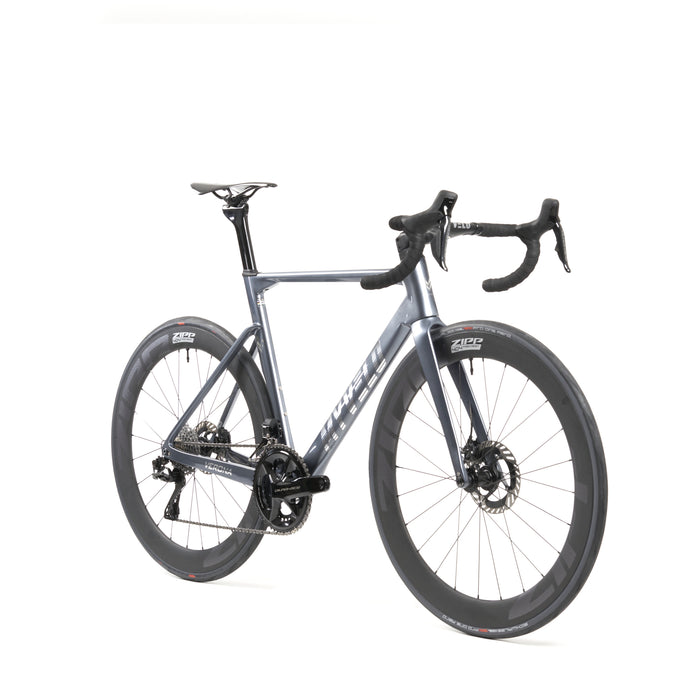
Verona road bike
incl. FREE shipping & free returns

When it comes to speed on a road bike, aerodynamics is one of the decisive factors. At higher speeds, air resistance accounts for over 80% of the total drag. Therefore, if you want to ride faster, you should not only rely on the equipment but also optimize your riding position.
Von Vincent Augustin |
3 minutes read time

A good aero position can save watts and thus enable either higher speeds or longer endurance.
The higher the speed, the exponentially greater the effect of aerodynamic drag. While tire rolling resistance and mechanical resistance remain relatively constant, aerodynamic drag increases with the square of the speed. This means that small aerodynamic improvements can have a significant impact on performance. Even a small reduction in frontal area or an optimized body position can save several watts — watts that can then be invested in higher speeds or reduced fatigue.

Especially in competition or on longer solo rides, a more aerodynamic position can make the difference between success and failure. While drafting offers a significant advantage in a group, the aerodynamic position is especially crucial when battling against the wind alone or in a breakaway. But even ambitious recreational riders benefit from working on their posture, as a more aerodynamic riding style is often more efficient and less strenuous over long distances.

The drops-bar position is one of the easiest ways to reduce drag. Grip the road bike handlebars by the drops, lower your upper body, and keep your head as low as possible.
Advantages:
✔ Reduced air resistance
✔ More stable position at high speeds
✔ Better control in strong headwinds
Disadvantages:
✖ Can be tiring on long journeys
✖ Less control in technical terrain
In this position, you rest your forearms loosely on the top of the handlebar, while your hands rest loosely on the top of the brake lever. This reduces the frontal area without significantly compromising comfort.
Advantages:
✔ Good compromise between aerodynamics and comfort
✔ Longer lasting than the lower link position
✔ Quickly accessible to the brake levers
Disadvantages:
✖ Not as aerodynamic as the lower link position
✖ Less stable in strong crosswinds
For maximum aerodynamic advantage, some road cyclists use aero bars. These armrests allow for extreme forward lean of the upper body, minimizing drag.
Advantages:
✔ Maximum aerodynamics
✔ Large saving of watts
✔ Perfect for time trials or solo rides
Disadvantages:
✖ Limited maneuverability
✖ Not allowed in group races
✖ May be unusual or uncomfortable
An often overlooked but effective technique is bringing the elbows together toward the torso. This further reduces the frontal area.
Advantages:
✔ Low air resistance without additional equipment
✔ Works with all handlebar positions
✔ No restrictions on control
Disadvantages:
✖ Can be uncomfortable in the long run
✖ Requires good core stability

The right aero position can make a significant difference – for both ambitious amateur riders and professionals. Those who adjust their posture specifically can increase their speed without exerting more energy. Whether it's drops, aero bars, or locked elbows – the best position is always the one you can maintain for a longer period of time. Experiment with different positions and find out what works best for you!

Gravelbikes sind in den letzten Jahren zu echten Allroundern auf dem Fahrradmarkt geworden. Sie kombinieren die Sportlichkeit eines Rennrads mit der Robustheit eines Mountainbikes und sind ideal für alle, die sowohl auf Asphalt als auch auf Schotterwegen unterwegs sein wollen. Doch gerade Einsteiger stellen sich oft die Frage: Bekommt man ein gutes, modernes Gravelbike schon für unter 1000 Euro? Die Antwort lautet: Ja – wenn man weiß, worauf es ankommt.

Wer viel Rennrad fährt, kennt das Gefühl: Anfangs ist alles wunderbar – der Wind pfeift, die Beine laufen, die Strecke ist dein Element. Doch nach einer Stunde meldet sich dein Hintern. Erst leicht, dann stechend, schließlich so brennend, dass jeder Tritt zur Qual wird. Willkommen im Club: Satteldruck und gereizte Haut gehören zu den häufigsten Beschwerden unter Radfahrer*innen – und kaum jemand spricht offen darüber.
Zeit, das Tabu zu brechen.

For many, coffee is as much a part of their morning routine as a racing jersey is to their bike. But did you know that caffeine is much more than just a stimulant in endurance sports? Studies show that it can noticeably improve your performance – if used correctly. But as is so often the case, the devil is in the detail: dosage, timing, and individual tolerance determine whether caffeine is a real boost or an underestimated risk.